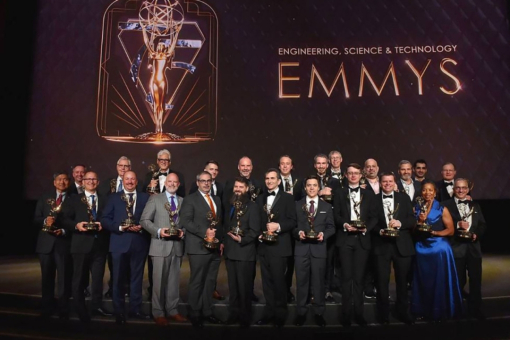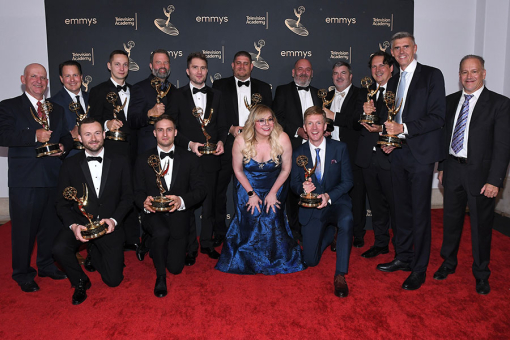Watch the 2015 Engineering Emmy Awards Presentation and see photos from the evening.
Back in 1979, on a filming break from Little House on the Prairie, former-pro-footballer-turned-actor Merlin Olsen had a conversation with cinematographer Garrett Brown, who was on hand to operate the Steadicam, the handheld camera-stabilizing mount he had created.
"He got to talking to me about how ridiculous it is that the camera is always back in the safety [end zone]," Brown recalled. "He said, 'Gosh, it would be great if you could have a helicopter fly right close to the action.'"
Though Brown initially demurred, thinking the prospect too dangerous, the idea eventually took hold, and in 1984, the Skycam – a computer-controlled camera mount system suspended via cable above the playing field – made its debut. Brown went on to invent the MobyCam, DiveCam, FlyCam and GoCam, among other devices, capturing athletes underwater, on the ski slopes and elsewhere and opening up new visual experiences for creators and audiences alike.
For his achievements, Brown was honored with the Charles F. Jenkins Lifetime Achievement Award at the 2015 Engineering Emmy Awards. The ceremony celebrates, as the Television Academy's Engineering Committee Chair Wendy Aylsworth said in her welcome, "the best and brightest of the technical people and engineers who create the foundation on which this industry exists."
Held October 28 at the Loews Hollywood Hotel and hosted by Josh Brener, one of the stars of the HBO comedy Silicon Valley, the event bestowed five honors. Brown related his conversation with Olsen during his acceptance speech for the Jenkins award. He had been introduced by Richard Crudo, president of the American Society of Cinematographers, who noted, "In tens of thousands of productions over the last 40 years, there's nothing you haven't seen that has not been influenced by [Brown] in some way. There is no way to overstate his contribution to what we do."
For his part, Brown modestly said that the award had "overwhelming qualities. I started as a lone inventor, which is a misnomer. There is a host of souls with me who inspired, implemented, helped, suggested and made possible. I will be undyingly grateful to them."
Two of those souls were in the audience: Haskell Wexler, the first cinematographer to use the Steadicam, in his Academy Award-winning turn in Bound for Glory, and Steve Tiffen, whose Tiffen company now manufactures the Steadicam. For one crane shot in Bound for Glory, Brown was so nervous that an observer noted, "That's funny. You're shaking and the shot is stable."
Concluded Brown, "I've had help, wonderful colleagues and great friends in this business. I am thrilled and delighted to have the Charles F. Jenkins Lifetime Achievement Award, and I thank you very much."
Grass Valley USA, LLC, received the Philo T. Farnsworth Award, given to an agency, company or institution whose contributions have significantly influenced television technology and engineering. Grass Valley's contributions include providing tools to create signal infrastructure as the television industry evolved; leadership in video routing, switching and manipulation; and pioneering efforts in digital image processing and effects.
Michael Cronk, the company's senior vice president of strategic marketing, accepted. Grass Valley was part of the first color television broadcast of the Olympics, in 1968, he noted, and of the Apollo space program, with Apollo 10 in 1969.
"We've had innovative switcher products, the first commercial video server, and have continued to be honored with 20 Emmys – this is our 21st," Cronk said. "This is a very big honor. That passion and that drive are still alive in the employees at Grass Valley. I'm honored to accept this award, and look forward to the innovations within the industry, well into the future."
Three Engineering Emmys were presented, recognizing significant engineering developments or innovations that affect the transmission, recording or reception of television. Those recipients were:
Mark Franken, inventor of EdiCue, an application whose software incorporates a workflow that allows sound supervisors to create and update ADR cues within ProTools. Used throughout the world, the system simplifies the re-syncing of cues to picture changes and uses visuals to confirm the cue timing is accurate.
"I'm grateful that I get to do what I do for a living, and to be able to receive this recognition," Franken said in acceptance.Michael Sechrest, Chris King and Greg Croft for SpeedTree, a software that improves the ability to design and computer-generate the specific trees and vegetation desired for a production.
"Wow. So when you make trees for a living, it's a pretty silly way to make a living, but here we are," King said in acceptance. "Thank you so much for this tremendous honor."Zhou Wang, Alan Bovik, Hamid Sheikh and Eero Simoncelli for Structural Similarity (SSIM) Video Quality Measurement Model, an algorithm which estimates viewer perception of the quality of an image or video. Used to test and improve video quality throughout the cable and satellite television industries, SSIM utilizes neuroscience-based models of the visual centers of the human brain, and can predict what parts of an image will appear distorted to viewers, thereby improving video quality.
"Engaging academics with television, we think, is a great thing," Bovik said in acceptance, because students and professors are exposed to new ideas in technology. "We thank the Television Academy for this tremendous honor. We never imagined the impact SSIM would have on the television industry."











